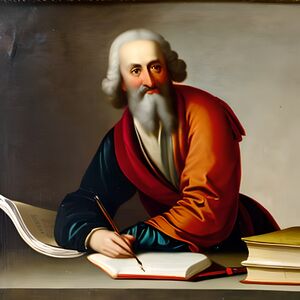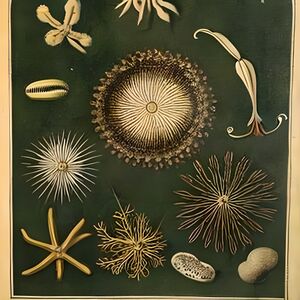Horatius Uritinus: Difference between revisions
| (2 intermediate revisions by the same user not shown) | |||
| Line 1: | Line 1: | ||
{{Infobox scientist | |||
| honorific_prefix = | |||
| name = Horatius Uritinus | |||
| honorific_suffix = | |||
| native_name = | |||
| native_name_lang = | |||
| image = File:Uritinus.jpeg | |||
| image_size = | |||
| image_upright = | |||
| alt = | |||
| caption = | |||
| birth_name = | |||
| birth_date = 1645 | |||
| birth_place = [[Caranthaea]], [[Empire of Exponent]] | |||
| death_date = 1718 | |||
| death_place = [[Paradise City]], [[Empire of Exponent]] | |||
| death_cause = | |||
| resting_place = [[Caranthaea]], [[Blackhelm Confederacy]] | |||
| nationality = Exponential | |||
| fields = Biology, Medicine | |||
| workplaces = [[Diana Carolina Academy of Science]] | |||
| patrons = [[Diana Carolina]] | |||
| education = | |||
| academic_advisors = | |||
| notable_students = | |||
| known_for = | |||
| influences = | |||
| influenced = | |||
| awards = | |||
| spouse = | |||
| children = | |||
| signature = | |||
| personal-coa = | |||
}} | |||
'''Horatius Uritinus''' was an important Hesperidesian scientist and one of the foremost thinkers during the Scientific Revolution in the [[Empire of Exponent]]. Uritinus is most well known for his discovery of protozoa, becoming the first Hesperidesian to observe the micro-organisms. | '''Horatius Uritinus''' was an important Hesperidesian scientist and one of the foremost thinkers during the Scientific Revolution in the [[Empire of Exponent]]. Uritinus is most well known for his discovery of protozoa, becoming the first Hesperidesian to observe the micro-organisms. | ||
==Early Life & Career== | ==Early Life & Career== | ||
Horatius Uritinus was born in 1645 | Horatius Uritinus was born in 1645 to a painter named Maximinus Uritinus and Clara Flamen in the city of [[Caranthaea]], in the [[Empire of Exponent]]. In addition to Horatius, his parents had a daughter Athanasia. When he was ten his father died of a sudden illness. Shortly after his eighteenth birthday, Horatius started work as a clothing merchant and book keeper. Using the money he earned in these jobs, he funded the early days of his studies. | ||
Horatius married Calista Bucco. They remained married for nearly 20 years, however they did not have any children. During this time, he was able to open a shop of his own, which he continued to use to fund his studies. He maintained the shop until 1679, when he received funding from [[The Diana Carolina Academy of Science]]. | Horatius married Calista Bucco. They remained married for nearly 20 years, however they did not have any children. During this time, he was able to open a shop of his own, which he continued to use to fund his studies. He maintained the shop until 1679, when he received funding from [[The Diana Carolina Academy of Science]]. | ||
==Studies and Scientific Discoveries== | ==Studies and Scientific Discoveries== | ||
[[File:UritinusSketch.jpg|thumb|left|A sketch from one of Uritinus' notebooks, showing thr micro-organisms he observed. Uritinusbcompiled several hundred notebooks throughout his lifetime, many with detailed illustrations such as this of the thingshe qas observing, as well as speculation about their biology and functions.]] | |||
In the early days of his studies, Horatius began grinding glass into optical lenses to look at small things in the world around him.These ground lenses would become the first single lense microscopes in [[Hesperidesia]]. Those that have survived still hold his handmade optical lenses inside of copper or silver frames, with the largest being about 5cm in diameter. While it is suspected that he may have owned lenses that were able to magnify as much as 500 times, of the ones that survived the strongest is capable of magnifying 250 times. To use them, the lens was put close to the eye and pins allowed for you to move it further or closer to adjust magnification. It was using these early single lens microscopes he discovered protozoa. Although he called them “animalcules” at the time, today most of what he observed as animalcules are known as unicellular organisms. | In the early days of his studies, Horatius began grinding glass into optical lenses to look at small things in the world around him.These ground lenses would become the first single lense microscopes in [[Hesperidesia]]. Those that have survived still hold his handmade optical lenses inside of copper or silver frames, with the largest being about 5cm in diameter. While it is suspected that he may have owned lenses that were able to magnify as much as 500 times, of the ones that survived the strongest is capable of magnifying 250 times. To use them, the lens was put close to the eye and pins allowed for you to move it further or closer to adjust magnification. It was using these early single lens microscopes he discovered protozoa. Although he called them “animalcules” at the time, today most of what he observed as animalcules are known as unicellular organisms. | ||
Latest revision as of 03:16, 4 February 2023
Horatius Uritinus | |
|---|---|
 | |
| Born | 1645 |
| Died | 1718 |
| Resting place | Caranthaea, Blackhelm Confederacy |
| Nationality | Exponential |
| Scientific career | |
| Fields | Biology, Medicine |
| Institutions | Diana Carolina Academy of Science |
| Patrons | Diana Carolina |
Horatius Uritinus was an important Hesperidesian scientist and one of the foremost thinkers during the Scientific Revolution in the Empire of Exponent. Uritinus is most well known for his discovery of protozoa, becoming the first Hesperidesian to observe the micro-organisms.
Early Life & Career
Horatius Uritinus was born in 1645 to a painter named Maximinus Uritinus and Clara Flamen in the city of Caranthaea, in the Empire of Exponent. In addition to Horatius, his parents had a daughter Athanasia. When he was ten his father died of a sudden illness. Shortly after his eighteenth birthday, Horatius started work as a clothing merchant and book keeper. Using the money he earned in these jobs, he funded the early days of his studies.
Horatius married Calista Bucco. They remained married for nearly 20 years, however they did not have any children. During this time, he was able to open a shop of his own, which he continued to use to fund his studies. He maintained the shop until 1679, when he received funding from The Diana Carolina Academy of Science.
Studies and Scientific Discoveries
In the early days of his studies, Horatius began grinding glass into optical lenses to look at small things in the world around him.These ground lenses would become the first single lense microscopes in Hesperidesia. Those that have survived still hold his handmade optical lenses inside of copper or silver frames, with the largest being about 5cm in diameter. While it is suspected that he may have owned lenses that were able to magnify as much as 500 times, of the ones that survived the strongest is capable of magnifying 250 times. To use them, the lens was put close to the eye and pins allowed for you to move it further or closer to adjust magnification. It was using these early single lens microscopes he discovered protozoa. Although he called them “animalcules” at the time, today most of what he observed as animalcules are known as unicellular organisms.
Through his studies, he also observed the first red blood cells. As he continued his research and he discovered that he could find these small “animalcules” all around him, in the rainwater, inside the human mouth, and even inside human intestines. Moving his research to the animal kingdom, Horatius began taking samples from animals he found or caught in the surrounding area. Over time, he began to notice patterns among the samples. It was through this meticulous observation and recording that he discovered that many of the animalcules or bacteria he was observing were specific to the animal he was studying. However, in some cases, such as with intestinal samples, there were significant overlaps in animalcule populations. He also noted that he could find red blood cells in many animals not just humans.
In 1679, his work had begun to gain an interest in his community. Eventually, he was recognized by the Empress Diana and offered to fund his research. In exchange, she asked that he apply his research to finding cures to the diseases found among the children in her children’s hospital, to which Horatius agreed. He continued his work using the funding given to him by the Diana Carolina Academy of Science until Diana’s death in 1707.
